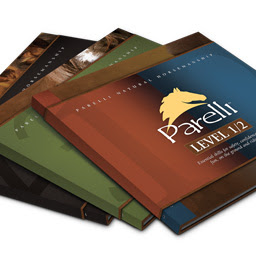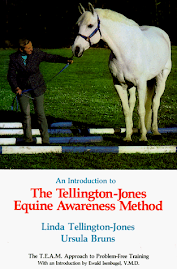1 Dressage is not just for competition. It is gymnastics for horses and all horses can benefit from it, as they are more likely to stay sound with a long, stretchy neck, soft body and easy movement.
2 You don't have to spend a fortune on a horse for dressage - as long as the basic paces are there, the rest can be acheived through training. The main paces to look at are walk and canter, as with a bit of work a horse with a very normal trot can trot beautifully.
In walk, the horse should use the whole of his body and have a good overtrack, where the hind foot lands in front of the print left by the front foot. A good canter has a bounding stride, with the hindleg jumping right underneath the horse and the front end lifted. Above all, though a good, natural rhythm is essential and is always more important than big movement.
3 When a horse is tired, he’ll try to stretch down. Let him do it for a while as it’s something you want to encourage. To stretch your horse, lengthen the rein, lower your hand and massage his mouth with the bit by gently squeezing and releasing each rein. Stretch him regularly throughout your training sessions to relax him and reduce the risk of tension.
4 In canter always ride forward – imagine there’s a big jump at the end of the long side that you’re going to take on!
5 Dressage is about repetition, repeating exercises over and over again until it becomes part of the horse’s way of going. It takes dedication, but is simply about producing a well-schooled horse – something we’d all like to have!
6 Even if your thing is dressage, mix your horse’s schooling up with hacking and jumping as it will keep him relaxed and interested.
7 Always compete at the level below the one you are working on at home, so that you are able to cope at the competition where there are many more distractions.
8 Mirrors are a huge help in training as they enable you to see what your horse is doing – for example, how do you know whether he is straight without being able to see him?
9 Working-in is one of the most important aspects of dressage. You want your horse to be long, round and stretching before you start more taxing work, to get the muscles in front of and behind the saddle soft and working – gymnasts don’t hop straight onto the top bar! Ideally, walk for 10 minutes to start with, but if your horse is fresh, it is best to trot on to settle him down.
10 Your horse must work in front of the leg. This means that he should move forward of his own accord and not expect you to keep motivating him – for example, if you ask for canter, he must learn to stay in canter without any leg pressure, until you tell him otherwise.
11 If your horse is not responsive to your leg, ask for halt and with a loose rein, give him sharp quick taps with your leg until he moves forward – it doesn’t matter what pace he goes into, just let him move forward.
12 Create a work station on your yard, where everything to do with work happens – for example, tacking up and washing off – and keep his stable for relaxation only. Then your horse knows he can totally relax when he’s in his stable and won’t be expected to work.
13 If your horse is too sensitive to the leg, work on lots of downward transitions.
14 Lots of transitions between canter and trot will help to improve the trot by getting him to carry more weight on his back end.
15 To maintain balance while you’re working your horse, use lots of half-halts. Think about using one before you ask your horse to do anything.
16 Give your horse sugar during training sessions as a reward and to help him mouth the bit, which will encourage him to salivate and make him lighter in the hand.
17 Riding your horse ‘on and back’ involves asking him for a few lengthened strides before asking him to come back to his working pace, then repeating it several times. This will help you to get him to carry his head and neck, and achieve self-carriage.
18 When doing tempi changes – a series of flying changes – with more advanced horses, we ride along the wall of the arena to help keep the horse straight.
19 With a horse who is trained to do collected canter, you want to aim for a speed where someone can walk alongside you.
20 Use leg-yield in canter to make your horse more aware of your legs.
21 To help you maintain the rhythm while riding, keep a song in your head and sing it to yourself while you ride.
22 Get someone to video you riding so you can see what’s working and where things are going wrong. Sometimes it’s more beneficial than having someone on the floor telling you what you’re doing wrong.
23 A good trot is all about suspension. When our horses are strong enough, we teach passage and use it to get suspension in the trot. We rise while doing this exercise, as it makes it easier for the horse and encourages lift. From passage, we take the trot forward until he realises that he needs to keep the suspension that he had in passage. If he loses the suspension, we halt, ask for passage and then try it again until he maintains the suspension in trot.
24 As a test of your training technique, go into rising trot and drop your reins. Your horse should stretch down, but if he sticks his head up, something needs adjusting in your training.
25 Never tell your horse off when teaching him flying changes, just keep repeating them until he gets it right, or he’ll start to get nervous and tense about doing them.
26 If you can’t halt square on the centre line, it’s your fault! It requires training, so to make sure you can do this, teach your horse that he must always stand square, even for mounting and dismounting. To teach your horse to stand square, ask for it along the side of the school. Trot, ask for a few steps of walk, then step forward into halt. He must step forward to halt, not back to halt.
27 Hacking up hills will help with fitness and muscle development.
28 In walk, try not to interfere too much and remember that during a test, a long walk on a free rein is not a time for a break! It requires as much attention and concentration as the other movements.
29 Don’t rush your schooling and ask for too much, too soon. It’s important that your horse is strong enough to be able to do what you’re asking him to do, or he could suffer injury. It normally takes four to five years to get to Grand Prix level, without any problems along the way, as it takes that long for the horse to become strong enough to perform the movements required at that level. If you have any setbacks, it can take longer and often does.
30 When you stop and salute the judge at a competition, remember to smile!?
31 Get to a show in plenty of time and hack your horse around the showground on a loose rein, so he has time to get used to his surroundings before he is expected to concentrate.
32 Plenty of turnout allows your horse time to relax and he’ll be more relaxed during his training.
33 At competitions, wear clothes and tack that you and your horse are used to and comfortable in. Suddenly using different equipment on competition day can affect your performance. If you have special show boots and tack, have a few dress rehearsals at home just before the show date.
34 The key to training horses is patience and consistency – you will get there!
35 If possible, recreate the type of arena you’ll be riding your test in at the competition and have a practice in it. For example, check what size the arena will be and measure one out the same size at home to practise the test in, or if you usually work in a school, but the competition is on grass, practise riding the test on grass.See More
Join Us for Move 26 in ’26
4 weeks ago































































After study a few of the posts on this website now, and I truly like your way of blogging. I bookmarked it and will be checking back soon.
ReplyDeleteMassage Training Online
Love it!
ReplyDelete